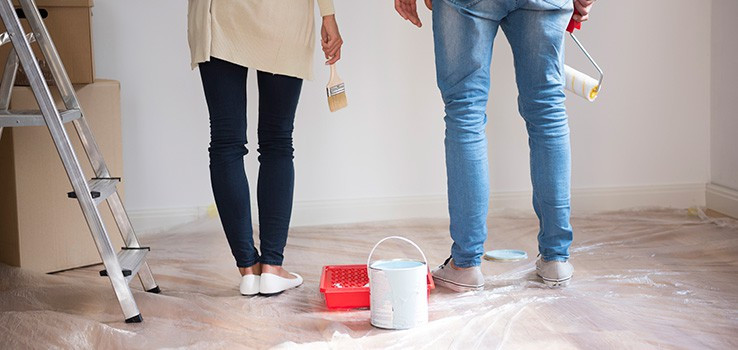Probably the quickest way to Pimp up your home would be to decorate.
Just like all other forms of home improvement there are certain procedures to follow. This is to ensure a trouble free and professional finish every time.
There are two forms of interior decorating. You can either opt for an all paint finish or the use of wall papers. Depending on your choice, the procedures will vary. But in both cases the first step still remains the same and of prime importance to the end result.
This is the art of surface preparation.
Virtually any surface to be decorated should be flat and free from grease and dust. Never be tempted to skimp on this important stage as it will later assist you in completing the job. In most cases this will require a quick light sanding to the walls and ceiling. Along with the application of fillers to any obvious cracks and a light sanding to all woodwork too (skirting and architraves etc).
Based on our own experiences, a quick tip is to use a powder based, unmixed filler. Unlike many of the available premixed fillers, it doesn’t dry as hard and is easier to sand flat afterwards.
So, having filled all the obvious cracks, keyed all our woodwork and had a quick tidy up.
What do we do next?
The general rule in all decorating is to start at the top and work down.
Let’s imagine for a minute that we break this rule.
We have papered our walls, but now we want to paint the ceiling. First off, we need to be really accurate in painting around the tops of the walls (more effort). And what if the paint used on the ceiling splashes over the walls? And ruins what we have already done?
Also, by taking this route, none of our surfaces have overlapped. Leading to missed areas and ‘dark lines’ in internal corners.
The greatest enemy of any decorator is the black line. No matter how good your finish, a ‘black line’, be it a crack on an internal corner or a raised overlap in your wallpaper, will always catch the eye first. And later spoil the overall effect of your efforts.
It’is for this reason alone, a decorator’s primary objective, is the removal of all black lines. Along with cracks and hollowly shadows. Rather than the blanket coverage of large surfaces, this is where he concentrates his efforts.
So let’s get decorating.
Starting at the top, we have decided to paint the ceiling. This is your first objective. For that an emulsion based paint is best suited. It tends to be a lot more flexible than gloss (oil) based paints. It is also less prone to cracking later.
Our choice of paint doesn’t stop there though. we now have to choose between a matt finish or a silk (shiny) finish. This choice is down to the individual . But again, experience tells us shiny finishes tend to exaggerate any flaws in what should be a relatively flat surface. Please bear this in mind.
Painting can now commence. When painting any large areas we generally opt for two different tools to complete the job. Brushes and rollers. Although paint pads or other options are available.
The weakest parts of any large area are the edges as our eyes are naturally drawn to the extremes rather than the bulk.
It is for this reason that we must ‘cut in’ the edges. Use a brush for this, as it tends to carry a lot more paint. And can be better used in corner situations.
So now for the scary bit, let’s go cut in the ceiling.
Using our brush…
We paint round the edges (cut in) coming into the ceiling by about 5 or six inches. This will enable a roller to stop short of the corners whilst still ensuring a good overall coverage. Flood all the corners where the ceiling meets the walls and don’t be afraid of coming down the walls by as much as two inches too.
Emulsion paint has excellent filling qualities and its liberal use in the corners will help ensure that any hairline cracks will disappear. None of those intrusive ‘black lines’ will be visible when done. And it will be a much better job all-round.
If you have a papered ceiling, it will also do no harm in running along the paper’s joints with your brush whilst cutting in.
This will help fill any cracks along these joints. And should you be unfortunate enough to have a papered ceiling where paper’s coming away, you can normally re-fix it at the same time. Do this by tearing back the paper, flooding the back of it with your paint and then painting the paper back into place.
The more paint we use here, the better.
Our next objective is to cut in around the light fittings. Always paint away from the light fitting sufficiently enough to later allow your roller to cover the bulk without touching it.
And have a damp cloth at the ready. So if you do touch the fitting with your paint you can easily clean it off before it dries.
And that’s the cutting in finished.
With all the edges cut in, it’s time to hit the bulk. And for that we use a roller.
Our roller choice is somewhat dependent on the texture of the ceiling. Generally speaking, the more textured a surface has, the thicker the pile has to be on the roller.
Another rule though, is that the thicker the pile on the roller, the more textured the effect of finished paint. We’re only talking orange peel, not mountains. The differences are somewhat negligible to the untrained eye. But it is still worth mentioning.
When rolling a paint surface, there are a few rules to bear in mind. Firstly, always keep the roller wet. The more paint we use, the better the finish.
And don’t try to finish the whole ceiling with just one loading of the roller, it just won’t happen. Regularly refresh the paint on your roller. And keep your pressure even when rolling. The harder you press, the more your roller will spit back at you. Likewise, the faster you roll the more it will spit too.
Always work in an orderly fashion.
By starting at A, steadily progress toward B. Where B is a completed ceiling.
But whilst being methodical, don’t be too regimented in your coverage. Straight lines draw the eye. And a too regimented application will lead to a ‘tram lines’ effect in the finish.
It is better to apply the paint in one direction first, then go back over it in a perpendicular direction. And use broad strokes to help ‘feather in’ the coverage. The most important rule though, is to do the whole area in one hit. Try to keep the whole area wet while you work. This always gives a better finish than doing two separate halves with an obvious join in the middle.
And one completed ceiling later…
We do it all again.
It is impossible to get a perfectly even and solid finish with just one coat. There will be misses and believe me, they will show. Look at it this way, the first coat merely seals in the existing surface with all its aged dirt, nicotine stains and dust.
Let’s face it; if it wasn’t dirty it wouldn’t have needed painting in the first place.
Our second coat is the decoration then. Its purpose is to help bulk up the coverage, cover any misses and help consolidate the whole finished effect.
There’s no getting away from it, so just knuckle down and get it done.
The best time to do any kind of painting, is during daylight hours.
It is only then that you can see the finished effect in all its glory.
And the lighting is at its most unforgiving during daylight hours. Which means it will more easily show up any flaws in your work.
If it looks right in daylight, it will never look any worse. This can’t be said about artificial lighting though. It’s a lot more directional in the way it projects.
So, we have prepped our surfaces and painted our ceiling.
So you finally have a completed ceiling. The two hardest parts of our decorating job are now completed and the rest is plain sailing by comparison. But where do we go from here?
Following our starting at the top rule and working down, it seems that the walls should be next. But that will depend upon what we intend to do with them.
If we intend to wallpaper (see How to Successfully Apply Wall Paper), then the walls will come in last believe it or not.
In this case we should now turn our attentions to the woodwork. So, if we have still got our emulsion brush at the ready, it’s a good idea to run around the tops of the shirting boards with it.
You’re deliberately flooding and thereby filling any cracks (black lines) where the skirting meets the plaster of the walls. While at the same time priming any bare wood as you go. Unlike an emulsion paint, gloss paints will always be absorbed by bare timbers rather than covering it.
And then we can leave it all to dry.
Once dried, the woodwork can then be finished off. This is done with the ubiquitous sanding, one coat of undercoat and 2 coats of gloss. With further light sanding and removal of dust between dried coats.
Still lurking in the background though, the ‘black line’ often frequents the joints between timber and plaster. Don’t be afraid to run your paint up the walls a little. The painted plaster surface will later assist with the wallpaper’s adhesion too.
If we intend to paint our walls however.
Then the walls are the next obvious place to go.
Ensuring that the ceiling is fully dried. We are ready to proceed with the walls. Tackling each wall individually.
Starting at the top, carefully cut in the wall. Because we previously ran our ceiling paint two inches into the wall, our wall paint will ‘glide’ more easily on the fresh paint below it. This makes it a lot easier to cut in a straight line in the corner between wall and ceiling. How good is that?
Once we have cut in the top, coming down by at least 5 inches to prevent our roller touching our newly painted ceiling. Continue down the sides and across The internal corners of skirtings and architraves. Again, flood filling as we go to kill those ‘black lines’.
Bish bash bosh, just slap it on.
Did you notice the top bit was the only part requiring any degree of accuracy there?
Again, if we are painting over wallpaper (Anaglypta for example), feel free to run up the joints whilst cutting in and re-stick any loose seams by first painting behind them then over them as we did with the loose ceiling paper.
Any sockets or light switches on this wall?
The best way to tackle these is to first unscrew them and gently pull them away from the wall. But only sufficiently enough to paint behind their edges. Coming away from them enough for your roller to miss (remember the damp cloth?).
And once again, our cutting in is completed.
With your roller now, take it all just one wall at a time. Remembering to keep the whole surface you’re working on wet as you complete the wall’s coverage. Then get rolling employing the same tactics as we did earlier on with the ceiling.
If all the walls are to be the same colour, you can proceed from one wall to the next, simply working your way around the whole room.
When you’ve completed your first lap of the room, and your first coat has sufficiently dried, remember our two coats rule. And set off around the room again. That’s cutting in and bulk filling while never forgetting your best friend, natural daylight.
If your walls are to be different shades.
It is always good practice to complete the lighter walls first. Moving on to the darker shades last.
Then, having gone twice around the entire room our walls are now complete and it’s looking good my friend. Go put the kettle on.
Later…
When all the walls and window reveals are dry. Just the woodwork remains to finishing off your room. But before you do that, how about putting all the sockets and switches back together again?
Having done that, we can now undercoat the woodwork. One coat will do for this as the worst areas should have already had a liberal coating of emulsion with its wonderful filling qualities. This should have been done whilst cutting in the walls (hopefully it was).
Like the cutting in of the walls where they meet the ceiling, the glossing procedures are the only remaining precision parts of the whole decorating process. And although it is possible to do this without the aid of masking tapes and safety nets, they could be beneficial. Depending on your levels of competence.
If you do use a masking tape, opt for the ‘low tack’ variety. These are specifically designed to not rip off your wall coverings (paper or paint) when you remove them.
Other than that, you just need patience and plenty of time for drying between coats. A much better finish is achieved by giving woodwork a light sanding between the undercoat and two top gloss coats.
When glossing, it is good practice to apply the paint sparingly and along the direction of the grain of the wood being painted. This helps eliminate the possibility of paint runs. Start at the door and work methodically around the room till you return to your starting point. And dare I say it, go round again while looking for paint runs. Work them away with your brush.
During the whole decorating process, the most important tool you will ever use is your eyes.
Take time to step back and peruse what you are doing as you go. Your eyes are the key to the success of any decent finish as it is those very eyes, that will be the judge of all your efforts. Not just now, every time you enter the room in the future.
And other than the time it takes for your paint to dry, if your room was a fully painted room, it should now be finished. Congratulations!
If not, take a look here for tips on hanging wall papers… Good luck!!
© Andy Robinson, Localad Services Handyman Assist
If you have enjoyed reading this article… Be sure to check out my many other Posts. Or better still, for up to the minute notifications of what I am up to, why not subscribe here for free?







Recent Comments